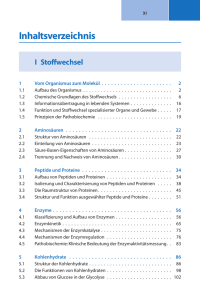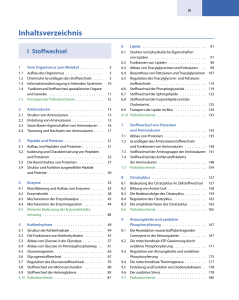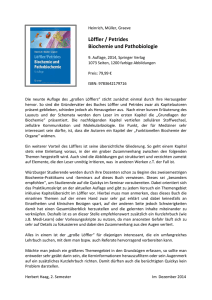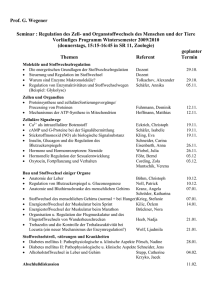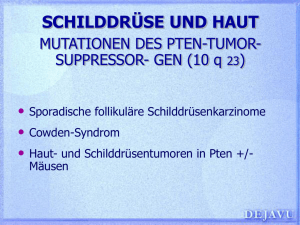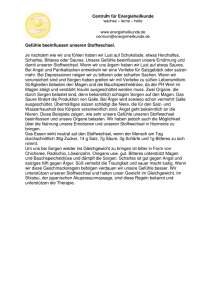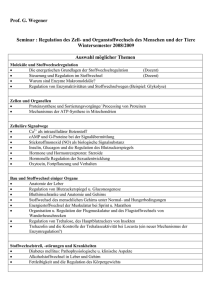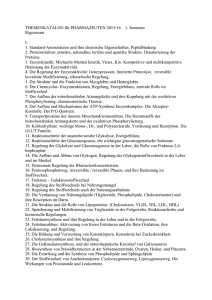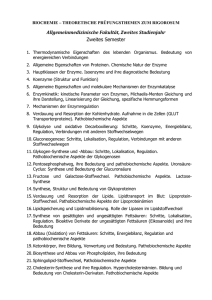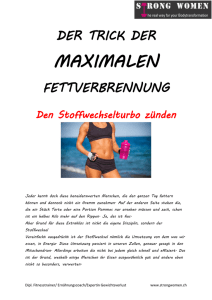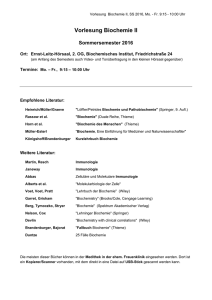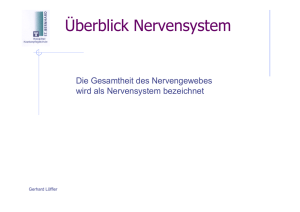Inhaltsverzeichnis
Werbung
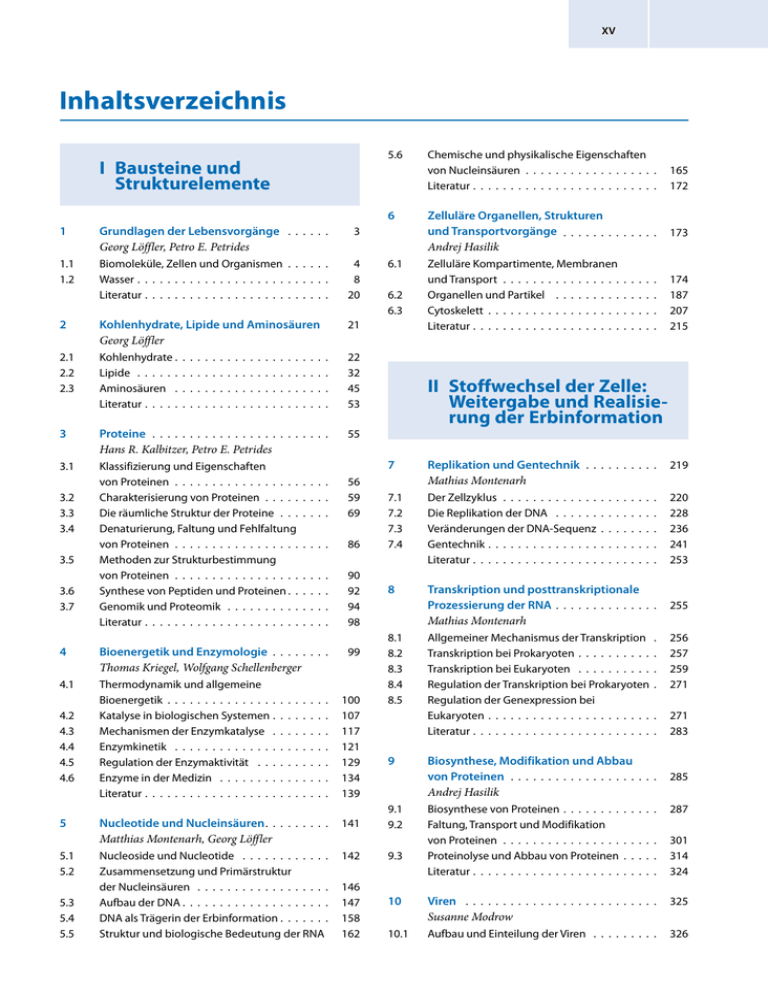
XV Inhaltsverzeichnis 5 6 . I Bausteine und Strukturelemente . 6 3 1 GrundlagenderLebensvorgänge . . . . . . . . GeorgLöffler,PetroE.Petrides 1 1 . 1 2 . . Biomoleküle, . . Zellen .und .Organismen . . . . . . . . 4 Wasser . . . . . . . . . . . . . . . . . . . . . . . . . . . . 8 Literatur . . . . . . . . . . . . . . . . . . . . . . . . . . . 20 2 ohlenhydrate,LipideundAminosäuren . . 21 K GeorgLöffler 2 1 . 2 2 . 2 3 . . Kohlenhydrate . . . . . . . . . . . . . . . . . . . . . . . . . . . . . . . . . . . . . . . . . . . . Lipide . . . . . . . . . . . . . . . . . . . . . . . . . . . . Aminosäuren . . . . . . . . . . . . . . . . . . . . . . . . Literatur . . . . . . . . . . . . . . . . . . . . . . . . . . . 3 Proteine . . . . . . . . . . . . . . . . . . . . . . . . . . 55 HansR.Kalbitzer,PetroE.Petrides 3 1 . 3 6 . 3 7 . . Klassifizierung . . und .Eigenschaften . . von .Proteinen . . . . . . . . . . . . . . . . . . . . . . . Charakterisierung .von .Proteinen . . . . . . . . . . . Die .räumliche .Struktur .der .Proteine . . . . . . . . . Denaturierung, . . Faltung .und .Fehlfaltung . . von .Proteinen . . . . . . . . . . . . . . . . . . . . . . . Methoden . . zur .Strukturbestimmung . . von .Proteinen . . . . . . . . . . . . . . . . . . . . . . . Synthese . . von .Peptiden .und .Proteinen . . . . . . . Genomik .und .Proteomik . . . . . . . . . . . . . . . . Literatur . . . . . . . . . . . . . . . . . . . . . . . . . . . 4 BioenergetikundEnzymologie . . . . . . . . . . 99 ThomasKriegel,WolfgangSchellenberger 4 1 . 4 2 . 4 3 . 4 4 . 4 5 . 4 6 . . Thermodynamik . . und .allgemeine . . Bioenergetik . . . . . . . . . . . . . . . . Katalyse .in .biologischen .Systemen . . Mechanismen .der .Enzymkatalyse . . . Enzymkinetik . . . . . . . . . . . . . . . . Regulation .der .Enzymaktivität . . . . . Enzyme .in .der .Medizin . . . . . . . . . . Literatur . . . . . . . . . . . . . . . . . . . 5 NucleotideundNucleinsäuren . . . . . . . . . . 141 MatthiasMontenarh,GeorgLöffler 5 1 . 5 2 . Nucleoside .und .Nucleotide . . . . . . . . . . . . . . . Zusammensetzung . . und .Primärstruktur . . der .Nucleinsäuren . . . . . . . . . . . . . . . . . . . . . Aufbau .der .DNA . . . . . . . . . . . . . . . . . . . . . . DNA . . als .Trägerin .der .Erbinformation . . . . . . . . . Struktur . . und .biologische .Bedeutung .der .RNA . . . 3 2 . 3 3 . 3 4 . 3 5 . 5 3 . 5 4 . 5 5 . . . . . . . . . . . . . . . . . . . . . . . . . . . . . . . . . . . . . . . . . . . . . . . . . . . . . . . . . 6 1 . 6 2 . 6 3 . . 22 32 45 53 56 59 69 86 90 92 94 98 100 107 117 121 129 134 139 142 146 147 158 162 . Chemische . und .physikalische .Eigenschaften . . von .Nucleinsäuren . . . . . . . . . . . . . . . . . . . . 165 Literatur . . . . . . . . . . . . . . . . . . . . . . . . . . . 172 ZelluläreOrganellen,Strukturen undTransportvorgänge . . . . . . . . . . . . . . 173 AndrejHasilik . Zelluläre . Kompartimente, .Membranen . . und .Transport . . . . . . . . . . . . . . . . . . . . . . . . Organellen .und .Partikel . . . . . . . . . . . . . . . . . . Cytoskelett . . . . . . . . . . . . . . . . . . . . . . . . . . . . . . . . . . . . . . . . . . . . . . . . . Literatur . . . . . . . . . . . . . . . . . . . . . . . . . . . 174 187 207 215 II Stoffwechsel der Zelle: Weitergabe und Realisie­ rung der Erbinformation 7 ReplikationundGentechnik . . . . . . . . . . . . 219 MathiasMontenarh 7 1 . 7 2 . 7 3 . 7 4 . . Der .Zellzyklus . . . . . . . . . . . . . . . . . . . . . . . . Die .Replikation .der .DNA . . . . . . . . . . . . . . . . . Veränderungen .der .DNA-Sequenz . . . . . . . . . . . Gentechnik . . . . . . . . . . . . . . . . . . . . . . . . . Literatur . . . . . . . . . . . . . . . . . . . . . . . . . . . 8 ranskriptionundposttranskriptionale T ProzessierungderRNA . . . . . . . . . . . . . . . 255 MathiasMontenarh 8 1 . 8 2 . 8 3 . 8 4 . 8 5 . . 9 9 1 . 9 2 . . Allgemeiner . Mechanismus .der .Transkription . . . . Transkription .bei .Prokaryoten . . . . . . . . . . . . . Transkription .bei .Eukaryoten . . . . . . . . . . . . . . .Regulation .der .Transkription .bei .Prokaryoten . . . Regulation . . der .Genexpression .bei . . Eukaryoten . . . . . . . . . . . . . . . . . . . . . . . . . Literatur . . . . . . . . . . . . . . . . . . . . . . . . . . . 220 228 236 241 253 256 257 259 271 271 283 iosynthese,ModifikationundAbbau B vonProteinen . . . . . . . . . . . . . . . . . . . . . . 285 AndrejHasilik 9 3 . . Biosynthese .von .Proteinen . . . . . . . . . . . . . . . .Faltung, .Transport .und .Modifikation . . von .Proteinen . . . . . . . . . . . . . . . . . . . . . . . Proteinolyse . . und .Abbau .von .Proteinen . . . . . . . Literatur . . . . . . . . . . . . . . . . . . . . . . . . . . . 287 10 Viren . . . . . . . . . . . . . . . . . . . . . . . . . . . . 325 SusanneModrow 10 1 . Aufbau .und .Einteilung .der .Viren . . . . . . . . . . . . 326 301 314 324 XVI Inhaltsverzeichnis 10 2 . 10 3 . 10 4 . 10 5 . . Virusvermehrung . . und .Replikation . . . . . . . . . . Folgen . . der .Virusinfektion .für .Wirtszelle . . und .Wirtsorganismus . . . . . . . . . . . . . . . . . . . Diagnostik .von .Virusinfektionen . . . . . . . . . . . . Prophylaxe . . und .Therapie .von .Virusinfektionen . . Literatur . . . . . . . . . . . . . . . . . . . . . . . . . . . 330 15 342 346 348 353 edoxreaktionen,Sauerstoffundoxidative R Phosphorylierung . . . . . . . . . . . . . . . . . . . 489 UlrichBrandt 15 1 . 15 2 . 15 3 . 15 4 . . . Energieumwandlung . in .den .Mitochondrien . Oxidoreduktasen . . . . . . . . . . . . . . . . . . Oxidativer .Stress . . . . . . . . . . . . . . . . . . . Pathobiochemie . . . . . . . . . . . . . . . . . . . Literatur . . . . . . . . . . . . . . . . . . . . . . . . 16 KoordinierungdesStoffwechsels . . . . . . . . 515 GeorgLöffler 16 1 . 16 2 . . . Nahrungszufuhr . und .Nahrungskarenz . . . . . . . . 516 Muskelarbeit . . . . . . . . . . . . . . . . . . . . . . . . 531 Literatur . . . . . . . . . . . . . . . . . . . . . . . . . . . 536 III Stoffwechsel der Zelle: Intermediärstoffwechsel 11 StoffwechselvonGlucoseundGlycogen . . . 357 GeorgLöffler 11 1 . 11 2 . 11 3 . 11 4 . Abbau .der .Glucose . . . . . . . . . . . . . . . . . . . . Der .Glycogenstoffwechsel . . . . . . . . . . . . . . . Die .Gluconeogenese . . . . . . . . . . . . . . . . . . . Regulation .von .Glucoseaufnahme .und . . -phosphorylierung . . . . . . . . . . . . . . . . . . . . Regulation . . des .Glycogenstoffwechsels . . . . . . . Regulation . . von .Glycolyse .und .Gluconeogenese . . Pathobiochemie . . . . . . . . . . . . . . . . . . . . . . Literatur . . . . . . . . . . . . . . . . . . . . . . . . . . . 11 5 . 11 6 . 11 7 . . 12 12 1 . 12 2 . 12 3 . 358 368 372 375 380 386 393 396 toffwechselvonTriacylglycerinen S undFettsäuren . . . . . . . . . . . . . . . . . . . . . 397 GeorgLöffler 12 4 . 12 5 . . Stoffwechsel .der .Triacylglycerine . . . . . . . . . . . Stoffwechsel .der .Fettsäuren . . . . . . . . . . . . . . Regulation . . des .Stoffwechsels .von .Fettsäuren . . und .Triacylglycerinen . . . . . . . . . . . . . . . . . . Ungesättigte . . Fettsäuren .und .Eikosanoide . . . . . Pathobiochemie . . . . . . . . . . . . . . . . . . . . . . Literatur . . . . . . . . . . . . . . . . . . . . . . . . . . . 13 StoffwechselderAminosäuren . . . . . . . . . . 427 Klaus-HeinrichRöhm 13 1 . 13 2 . 13 3 . Stoffwechsel .des .Stickstoffs . . . . . . . . . . . . . . . Stickstoffhaushalt .des .Menschen . . . . . . . . . . . Reaktionen . . und .Enzyme .im .Aminosäure- . stoffwechsel . . . . . . . . . . . . . . . . . . . . . . . . Übersicht . . über .den .menschlichen .Aminosäurestoffwechsel . . . . . . . . . . . . . . . . . . . . . . . . Aminosäurestoffwechsel . . der .Organe . . . . . . . . . .Stoffwechsel .einzelner .Aminosäuren . . . . . . . . . Literatur . . . . . . . . . . . . . . . . . . . . . . . . . . . 13 4 . 13 5 . 13 6 . . 398 403 428 430 432 438 444 454 476 14 DerCitratzyklus . . . . . . . . . . . . . . . . . . . . . 477 GeorgLöffler,UlrichBrandt 14 1 . 14 2 . 14 3 . 14 4 . . Stellung . . des .Citratzyklus .im .Stoffwechsel . . Reaktionsfolge .des .Citratzyklus . . . . . . . . Regulation .des .Citratzyklus . . . . . . . . . . . Amphibole .Natur .des .Citratzyklus . . . . . . Literatur . . . . . . . . . . . . . . . . . . . . . . . . . . . . . . . . . . . . . . . . . . . 478 479 484 486 488 . . . . . . . . . . 490 506 509 512 514 IV Stoffwechsel der Zelle: Biosynthese von Speicher­ und Baustoffen 17 BiosynthesevonKohlenhydraten . . . . . . . . 539 GeorgLöffler 17 1 . .Biosynthese .und .Stoffwechsel .von .Mono- . sacchariden . . . . . . . . . . . . . . . . . . . . . . . .Biosynthese .der .Zuckerbausteine .von .Glyco- . proteinen .und .Glycosaminoglycanen . . . . . . .Biosynthese .von .Oligosacchariden .und . . Heteroglycanen . . . . . . . . . . . . . . . . . . . . Literatur . . . . . . . . . . . . . . . . . . . . . . . . . 17 2 . 17 3 . . 414 418 425 425 . . . . . 18 18 1 . 18 2 . 18 3 . . . 540 . . 543 . . 546 . . 552 StoffwechselvonPhosphoglyceriden, SphingolipidenundCholesterin . . . . . . . . . 553 GeorgLöffler 18 4 . 18 5 . 18 6 . . Stoffwechsel .der .Phosphoglyceride . Stoffwechsel .der .Sphingolipide . . . . .Stoffwechsel .der .Isoprenlipide .und . . des .Cholesterins . . . . . . . . . . . . . . Lipide .und .Signalmoleküle . . . . . . . Transport .der .Lipide .im .Blut . . . . . . Pathobiochemie . . . . . . . . . . . . . . Literatur . . . . . . . . . . . . . . . . . . . . . . . . . . . 554 . . . . . . . . 559 19 StoffwechselderPurineundPyrimidine . . . 585 GeorgLöffler,MonikaLöffler 19 1 . 19 2 . 19 3 . 19 4 . . .Biosynthese .von .Purin- .und .Pyrimidin- . nucleotiden . . . . . . . . . . . . . . . . . . . . . . . . . Wiederverwertung . von .Purinen .und .Pyrimidinen . . . Abbau .von .Nucleotiden . . . . . . . . . . . . . . . . . Pathobiochemie . . . . . . . . . . . . . . . . . . . . . . Literatur . . . . . . . . . . . . . . . . . . . . . . . . . . . 20 HämundGallenfarbstoffe . . . . . . . . . . . . . 607 PetroE.Petrides 20 1 . Biosynthese .des .Häms . . . . . . . . . . . . . . . . . . 608 . . . . . . . . . . . . . . . . . . . . . . . . . . . . . . . . . . . . . . . . 564 571 572 580 583 586 597 599 602 605 XVII Inhaltsverzeichnis 20 2 . 20 3 . 20 4 . . .Pathobiochemie: .Störungen .der . . Hämbiosynthese . . . . . . . . . . . . . . . . . . . . . Abbau . . des .Häms .zu .Gallenfarbstoffen . . . . . . . Pathobiochemie: . . Störungen .des .Bilirubinstoffwechsels . . . . . . . . . . . . . . . . . . . . . . . . . . Literatur . . . . . . . . . . . . . . . . . . . . . . . . . . . 614 621 24 5 . 24 6 . 24 7 . 624 626 24 8 . . 25 V Stoffwechsel des Organis­ mus: Bedeutung von Nahrungskomponenten zelladhäsive .Glycoproteine . . . Nichtkollagene, . Abbau .der .extrazellulären .Matrix . . . . . . . . . Biochemie . . und .Pathobiochemie .des .Skelett- . systems . . . . . . . . . . . . . . . . . . . . . . . . . Biochemie .der .Haut . . . . . . . . . . . . . . . . . . Literatur . . . . . . . . . . . . . . . . . . . . . . . . . . . 730 . . 736 . . 737 . . 747 . . 754 KommunikationzwischenZellen: ExtrazelluläreSignalmoleküle,Rezeptoren undSignaltransduktion . . . . . . . . . . . . . . . 755 PeterC.Heinrich,SergeHaan, HeikeM.Hermanns,GeorgLöffler, GerhardMüller-Newen,FredSchaper 25 1 . 21 Ernährung . . . . . . . . . . . . . . . . . . . . . . . . . 631 HanneloreDaniel,UweWenzel 21 1 . 21 2 . 21 3 . 21 4 . 21 6 . . Energiebilanz . . . . . . . . . . . . . . . . . . . . . . . . 632 Der .Ernährungszustand . . . . . . . . . . . . . . . . . 638 Veränderungen . . der .Energiebilanz . . . . . . . . . . 639 Kontrollmechanismen . . der .Nahrungsaufnahme, . .Energie- .und .Nährstoffzufuhr . . . . . . . . . . . . . 642 .Die .Stoffwechselbedeutung .einzelner .Nährstoffe . . und .ihre .Beteiligung .an .der .Homöostase . . . . . . 644 .Besondere .Ernährungserfordernisse . . . . . . . . . 652 Literatur . . . . . . . . . . . . . . . . . . . . . . . . . . . 654 22 Spurenelemente . . . . . . . . . . . . . . . . . . . . 655 PetroE.Petrides 22 1 . 22 2 . . Allgemeine .Grundlagen . . . . . . . . . . . . . . . . . 656 Die .einzelnen .Spurenelemente . . . . . . . . . . . . 658 Literatur . . . . . . . . . . . . . . . . . . . . . . . . . . . 678 23 Vitamine . . . . . . . . . . . . . . . . . . . . . . . . . . 679 GeorgLöffler,ReginaBrigelius-Flohé 23 1 . 23 2 . 23 3 . 23 4 . . . Allgemeine . Grundlagen .und .Pathobiochemie . . . . . Fettlösliche .Vitamine . . . . . . . . . . . . . . . . . . . Wasserlösliche .Vitamine . . . . . . . . . . . . . . . . . Vitaminähnliche .Substanzen . . . . . . . . . . . . . . Literatur . . . . . . . . . . . . . . . . . . . . . . . . . . . 21 5 . 680 683 697 711 712 VI Stoffwechsel des Organismus: spezifische Gewebe .Extrazelluläre .Signalmoleküle .und .die . . Kommunikation . zwischen .Zellen . . . . . . . . . . . 757 25 2 . Stoffwechsel .und .Analyse .von .Hormonen .und . . Cytokinen . . . . . . . . . . . . . . . . . . . . . . . . . . 760 25 3 . Rezeptoren .für .Hormone .und .Cytokine . . . . . . . 763 25 4 . Prinzipien . . der .Signaltransduktion .von . . Membranrezeptoren . . . . . . . . . . . . . . . . . . . 769 25 5 . Einteilung .der .Cytokine . . . . . . . . . . . . . . . . . 777 25 6 . Signaltransduktion .G-Protein-gekoppelter . .Rezeptoren . . . . . . . . . . . . . . . . . . . . . . . . . 779 25 7 . Signaltransduktion .von .Rezeptor-Tyrosinkinasen . . und .Rezeptor-Serin/Threoninkinasen . . . . . . . . 785 25 8 . Signaltransduktion .über .Rezeptoren .mit . . assoziierten .Kinasen . . . . . . . . . . . . . . . . . . . 791 25 9 . Besondere .Aktivierungsmechanismen . . . . . . . . 801 25 10 . Regulation .der .Signaltransduktion . . . . . . . . . . 804 . Literatur . . . . . . . . . . . . . . . . . . . . . . . . . . . 807 26 DieschnelleStoffwechselregulation . . . . . . 809 HaraldStaiger,NorbertStefan,MonikaKellerer, Hans-UlrichHäring 26 1 . 26 2 . 26 3 . 26 4 . . Insulin . . . . . . . . . . . . . . . . . . . . Glucagon . . . . . . . . . . . . . . . . . . Katecholamine . . . . . . . . . . . . . . . Pathobiochemie: . . Diabetes .mellitus . . Literatur . . . . . . . . . . . . . . . . . . . 27 Hypothalamisch-hypophysäresSystem undZielgewebe . . . . . . . . . . . . . . . . . . . . . 841 JosefKöhrle,PetroE.Petrides 27 1 . 27 2 . 27 3 . 24 Binde-undStützgewebe . . . . . . . . . . . . . . 715 RainerDeutzmann,LeenaBruckner-Tuderman, PeterBruckner 24 1 . . . Zusammensetzung . der .extrazellulären . . Matrix .(ECM) . . . . . . . . . . . . . . . . . . . . . . . . Kollagene . . . . . . . . . . . . . . . . . . . . . . . . . . Elastische .Fasern . . . . . . . . . . . . . . . . . . . . . . Proteoglykane . . . . . . . . . . . . . . . . . . . . . . . 24 2 . 24 3 . 24 4 . 716 716 724 727 27 4 . 27 5 . 27 6 . 27 7 . 27 8 . . . . . . . . . . . . . . . . . . . . . . . . . . . . . . . . . . . . . . . . . . . Hypothalamisch-hypophysäre . Beziehungen . . . Hypothalamus-Hypophysen-Schilddrüsenhormonachse . . . . . . . . . . . . . . . . . . . . . . . .Hypothalamus-Hypophysen-Nebennieren- . rinden-(Zona .fasciculata-)Achse . . . . . . . . . . . .Hypothalamus-Hypophysen-Gonadenachse . . . . .Zielgewebe .der .Gonadotropine .beim .Mann . . . . .Zielgewebe .der .Gonadotropine .bei .der .Frau . . . . Die .Wachstumshormon-IGF-Achse . . . . . . . . . . Antidiuretisches . . Hormon .( Vasopressin) . . und .Oxytocin . . . . . . . . . . . . . . . . . . . . . . . . Literatur . . . . . . . . . . . . . . . . . . . . . . . . . . . 810 823 826 832 838 843 847 862 870 874 878 885 890 891 XVIII Inhaltsverzeichnis 28 unktionderNierenundRegulation F desWasser-undElektrolyt-Haushalts . . . . . . 893 ArminKurtz 28 1 . 28 2 . 28 3 . 28 4 . 28 5 . 28 6 . 28 7 . 28 8 . . Die .Niere . . . . . . . . . . . . . . . . . . . . . . . . . . . Der .Endharn .(Urin) . . . . . . . . . . . . . . . . . . . . Der .Wasserhaushalt . . . . . . . . . . . . . . . . . . . . Der .Natriumhaushalt . . . . . . . . . . . . . . . . . . . Der .Kaliumhaushalt . . . . . . . . . . . . . . . . . . . . Der . . Calcium- .und .Phosphathaushalt . . . . . . . . . Der . . Magnesium- .und .Sulfathaushalt . . . . . . . . . Der .Säure-Basen-Haushalt . . . . . . . . . . . . . . . Literatur . . . . . . . . . . . . . . . . . . . . . . . . . . . 29 Blut . . . . . . . . . . . . . . . . . . . . . . . . . . . . . 951 PetroE.Petrides 29 1 . 29 2 . 29 3 . 29 4 . 29 5 . 29 6 . . Korpuskuläre .Elemente .des .Bluts . Erythrozyten . . . . . . . . . . . . . . Leukozyten . . . . . . . . . . . . . . . Thrombozyten . . . . . . . . . . . . . Blutstillung . . . . . . . . . . . . . . . Plasmaproteine . . . . . . . . . . . . Literatur . . . . . . . . . . . . . . . . . . . . . . . . . . . . . . . . . . . . . . . . . . . . . . . . . . . . . . . . . . . . . . . . . . . . . . . . . . . . . . . . . . . . . . . 895 914 917 921 928 930 939 942 950 952 953 972 976 979 991 999 30 uskelgewebe . . . . . . . . . . . . . . . . . . . . .1001 M DieterO.Fürst,MatthiasGautel, PetroE.Petrides 30 1 . 30 2 . 30 3 . . Feinstruktur .der .Muskulatur . . . . . . . . . . . . . .1002 Die . . Proteine .des .kontraktilen .Apparats . . . . . . .1004 Molekularer . . Mechanismus .der .Muskel- . kontraktion .und .-relaxation . . . . . . . . . . . . . . .1009 Regeneration .der .Muskelzelle . . . . . . . . . . . . .1015 Pathobiochemie: . . Angeborene .und .erworbene . . Muskelerkrankungen . . . . . . . . . . . . . . . . . . .1017 Literatur . . . . . . . . . . . . . . . . . . . . . . . . . . .1022 31 Nervensystem . . . . . . . . . . . . . . . . . . . . . .1023 AstridScheschonka,HeinrichBetz, Cord-MichaelBecker 31 1 . 31 2 . 31 3 . . Stoffwechsel .des .Gehirns . . . . . . . . . . . . . . . .1024 Neuronale .Zellen . . . . . . . . . . . . . . . . . . . . .1029 Chemische . . Signalübertragung .zwischen . . Neuronen . . . . . . . . . . . . . . . . . . . . . . . . . .1036 Nicht-neuronale .Zellen . . . . . . . . . . . . . . . . .1045 Neurodegenerative .Krankheiten . . . . . . . . . . .1048 .Neuronale .Stammzellen .und .neurotrophe . . Faktoren . . . . . . . . . . . . . . . . . . . . . . . . . . .1051 Literatur . . . . . . . . . . . . . . . . . . . . . . . . . . .1051 32 Gastrointestinaltrakt . . . . . . . . . . . . . . . . .1053 GeorgLöffler,JoachimMössner 32 1 . 32 2 . Gastrointestinale .Sekrete . . . . . . . . . . . . . . . .1054 .Verdauung .und .Resorption .einzelner .Nahrungsbestandteile . . . . . . . . . . . . . . . . . . . . . . . .1068 .Das .Immunsystem .des .Intestinaltrakts . . . . . . . .1079 Literatur . . . . . . . . . . . . . . . . . . . . . . . . . . .1080 30 4 . 30 5 . 31 4 . 31 5 . 31 6 . 32 3 . . 33 Leber . . . . . . . . . . . . . . . . . . . . . . . . . . . .1083 DieterHäussinger,GeorgLöffler 33 1 . 33 6 . . . zellulären .Bestandteile .der .Leber .und . . Die . ihre .anatomischen .Beziehungen . . . . . . . .Funktionen .der .Leberparenchymzellen . . . Biotransformation . . . . . . . . . . . . . . . . . .Die .Leber .als .Ausscheidungsorgan . . . . . . .Funktionen .der .Nichtparenchymzellen . . der .Leber . . . . . . . . . . . . . . . . . . . . . . Pathobiochemie . . . . . . . . . . . . . . . . . . Literatur . . . . . . . . . . . . . . . . . . . . . . . 34 Immunsystem . . . . . . . . . . . . . . . . . . . . . .1103 SiegfriedAnsorge 34 1 . 34 2 . 34 6 . 34 7 . . Angeborene .Immunantwort . . . . . . . . . . . . .Molekulare .Instrumente .der .adaptiven . .Immunantwort . . . . . . . . . . . . . . . . . . . . . .Die .zellulären .Komponenten .des .adaptiven . .Immunsystems . . . . . . . . . . . . . . . . . . . . . Komplementsystem . . . . . . . . . . . . . . . . . .Wechselwirkungen .zwischen .unspezifischer . . und .spezifischer .Immunantwort . . . . . . . . . Immunabwehr . . von .Mikroorganismen . . . . . . Pathobiochemie . . . . . . . . . . . . . . . . . . . . Literatur . . . . . . . . . . . . . . . . . . . . . . . . . 35 Tumorgewebe . . . . . . . . . . . . . . . . . . . . .1141 PetroE.Petrides 33 2 . 33 3 . 33 4 . 33 5 . 34 3 . 34 4 . 34 5 . . . . . . . . . . .1084 . .1086 . .1090 . .1096 . . . .1098 . . . .1099 . . . .1102 . .1104 . .1105 . .1109 . .1130 . .1133 . .1134 . .1136 . .1139 35 1 . .Fehlregulation .des .Wachstums .und .der . . Differenzierung . bei .Tumoren . . . . . . . . . . . . . .1142 35 2 . .Tumorentstehung .(Cancerogenese) . . . . . . . . .1143 35 3 . Onkogene . . . . . . . . . . . . . . . . . . . . . . . . .1143 35 4 . Antionkogene . . . . . . . . . . . . . . . . . . . . . . .1145 35 5 . .Kumulative .Aktivierung .von .Onkogenen . . und .Inaktivierung .von .Antionkogenen .beim . .Mehrschrittprozess .der .Tumorigenese . . . . . . . .1150 35 6 . .Entstehung .von .Fusionsgenen .durch . . Translokationen . . . . . . . . . . . . . . . . . . . . . .1154 35 7 . .Mechanismen .der .Invasion .und .Metastasierung . .1155 35 8 . .Tumorentstehung .durch .Cancerogene . . . . . . .1157 35 9 . Stoffwechsel .von .Tumorgeweben . . . . . . . . . . .1159 35 10 . Früherkennung .von .Tumoren . . . . . . . . . . . . .1159 35 11 . Krebstherapie . . . . . . . . . . . . . . . . . . . . . . .1160 35 12 . . .Gentherapeutische .Ansätze .bei . . Krebserkrankungen . . . . . . . . . . . . . . . . . . .1161 . Literatur . . . . . . . . . . . . . . . . . . . . . . . . . . .1162 Anhang HäufigeAbkürzungen . . . . . . . . . . . . . . . . . . . . . .1164 Sachverzeichnis . . . . . . . . . . . . . . . . . . . . . . . . . .1167
